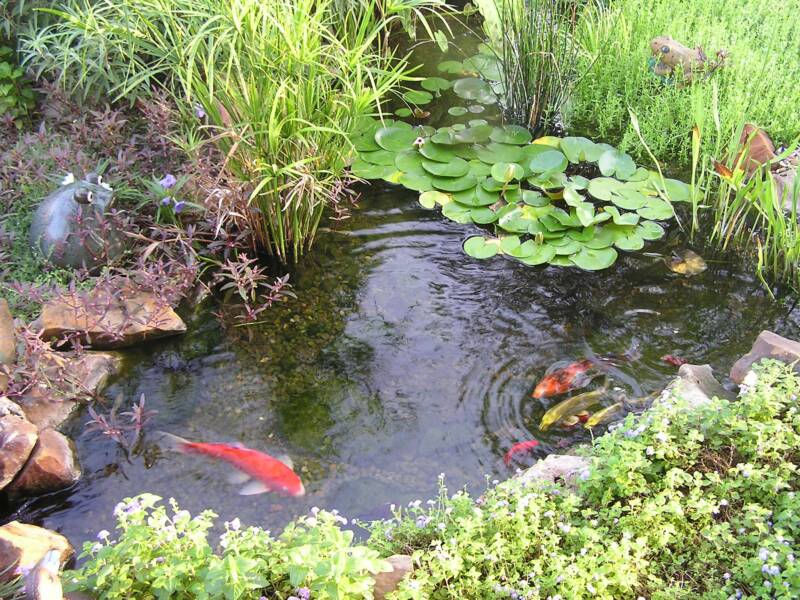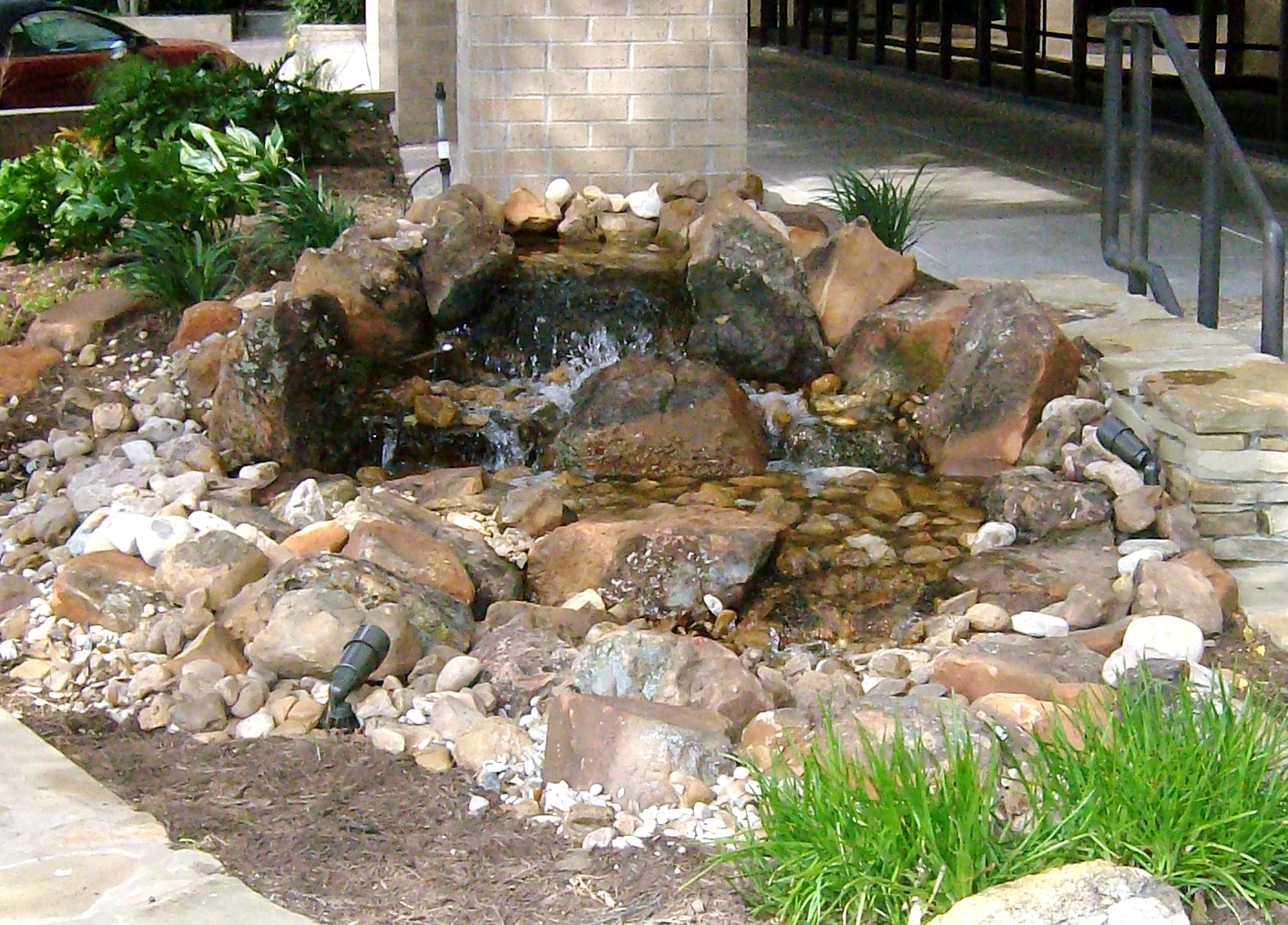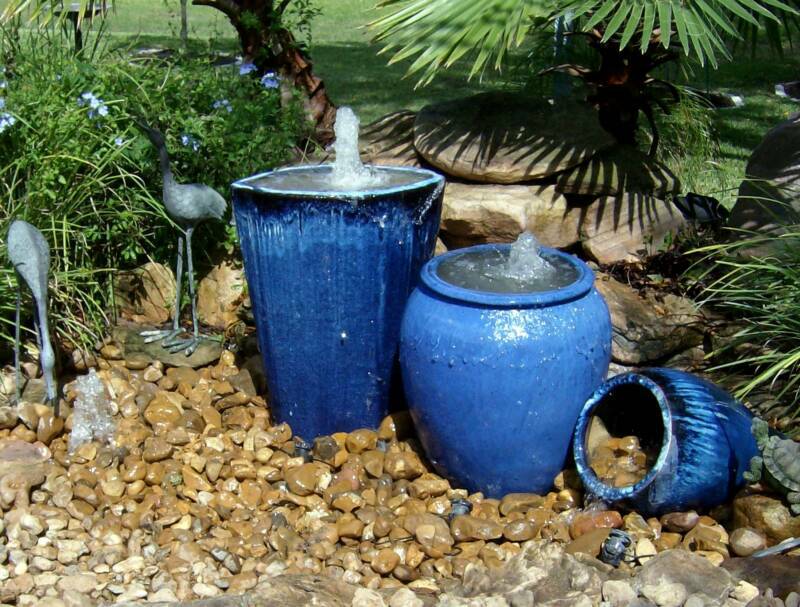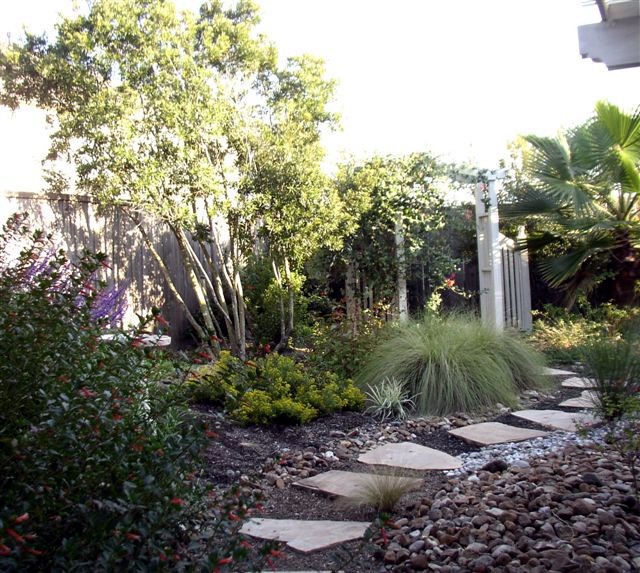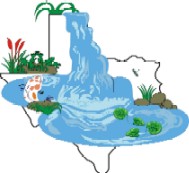


Rainwater Harvesting
Organic Ecosystem Ponds
Pondless Waterfalls
Urn and Fountain Features
Water-Wise Landscapes
Meet Your Water Feature Professionals


Texas Ponds and
Water Features
Spring Pond Clean-Outs
by Matt Boring
The Natural Water Gardener
A little spring cleaning never hurt anyone and is exactly what the organic water garden needs to start the yearly cycle of the ecosystem. A well designed pond system should be able to handle the waste from the fish and whatever dirt or sediments blow into the water for at least a year without being cleaned. Water gardens that are improperly designed or under-filtered require more frequent cleaning during other parts of the year. But spring is the ideal time to flush and clean an ecosystem-based pond. The fish are coming out of their winter slowdown and are ready to eat again. They are natural bottom feeders and you don’t want them mouthing around on a year’s worth of accumulated waste and sediment at the bottom of the pond. The plants are coming out of their dormancy and will soon be taking all the excess nutrients out of the water, starving the algae out of the ecosystem. It would be unfair to expect them to clean out all the nutrients that accumulate during their winter dormancy. They will, given time, but we can give them a hand by cleaning the pond and starting the system’s cycle again each spring.
Spring rains wash and renew creeks and streams, taking the excess nutrients downstream to lakes, bays, or oceans where a much larger aquatic ecosystem waits to devour them. When we clean out an ecosystem pond in the spring, we are trying to mimic nature in this respect. An organic ecosystem water garden mimics nature as much as possible, from how it looks to how it functions. The beneficial bacteria which colonize in the Biofalls filter and on the rocks and gravel of the pond itself constantly work to clean the system, just like in nature. They convert the harmful ammonia in the fish’s waste into ammonium nitrate- plant fertilizer- by way of the nitrite cycle, cleaning the water and fertilizing the aquatic plants at the same time. They also compete directly with the algae for the same waterborne nutrients, helping to literally starve the algae out of the system. The healthier and stronger the bacteria colonies in your pond, the less you’ll have problems with algae blooms reducing your enjoyment of your backyard escape.
The spring is the time of renewal, of making the garden fresh again to prepare for another year’s life cycle. In the vegetable and flower garden we mix compost into the soil and do other things to prepare for growing season. The organic water garden needs renewing this time of year too. The Biofalls biological filter should be cleaned once a year to flush out dead bacteria and sediments that may have collected in it. This will enable a fresh new colony of bacteria to establish itself for the upcoming seasons. Every pond is different and some ponds need to be cleaned out each spring. Some can go two or three years or even more without being cleaned. Warm climate ponds typically can go longer without cleaning because the bacteria colonies aren’t completely killed off each winter, taking up valuable surface area in the filter with dead bacteria. However, these same warm climate ponds have more need for their plants to be thinned out since they stay green and growing longer each year. And spring clean-out time is the easiest time of the year to thin out your aquatic plants.
To clean the average sized water garden is simple and should only take 2-3 hours for a couple of people. Critics of natural water gardening say that it’s impossible to clean a pond with rocks and gravel in the bottom of it, but the truth is that they are a lot easier to clean than traditional pond systems. All you have to do is get a water garden pump from your local water gardening professional. The one I use pumps around 4000 gallons per hour through a flexible hose and has a screened intake on the bottom. Place it in the lowest part of the pond. Turn off the pump in your skimmer. Remove the filtration media from the skimmer and biological filter and spread the mats out on the lawn. Now turn on the pump and use the flexible hose and the high pressure to easily clean the filters on the lawn. When the filters are clean, collect some of the pond water in a holding tank. You may need two, depending on how many fish you need to hold. After the holding tank(s) is full, continue to pump out water into the lawn, moving the hose around periodically. It’s nutrient rich and a great organic boost to your lawn in the spring. When there’s 6-8 inches of water left, turn off the pump and catch the fish, placing them in the tank. At this point I usually can catch most of the fish by hand. If I do need to use a net, I use one with a rubber coating so as not to damage the scales or gill of my babies. I also bring a battery-powered aerator to make sure that those fishy friends have enough oxygen while I’m working. After all the fish are safely in the tank, finish pumping out the water. Grab the water hose and with a high pressure nozzle, wash down the rocks and gravel starting at the highest part of the waterfall and working your way down. I don’t use a pressure washer because it can actually etch into Moss Rock, which is my favorite rock to use when building ponds. Besides, a little algae is both natural and desirable and will help keep the water clear until the plants and bacteria colonies have time to balance out the ecosystem again.
When you start, you’ll see the dirt and sediment washing out from between the rocks and gravel of the pond. Continue washing till the water runs out clean and then move on, pumping the dirty water out as you go. When the pond is clean, pick up any leaves, sticks, acorns, or whatever may have been missed by the skimmer. Use the pump to clean out the biological filter and skimmer box and re-install the filtration media. You can check and change light bulbs, prune back aquatic plants, and redistribute gravel that the Koi have moved while the pond is empty.
When your all finished cleaning the pond, throw a hose in and start refilling. Use dechlorinator to lock up the chlorine and make the water safe for the fish. Add some dechlorinated water from the pond to the holding tank slowly till the temperatures is about the same in both or float the fish in buckets in the pond until the temperatures equalize. Turn on your waterfall and gently release your fish. Then go get something cold to drink, sit back, relax, and feel proud of yourself. You’ve cleaned the water garden and watered and fertilized the lawn and other parts of your garden all at the same time.
Then you just add some bacteria each day for a couple of weeks to restart the colonies and let nature do its thing for another year. Sounds far better than hand-scooping 6 inches of fish waste per year while attempting to stand in a slippery black liner pond. Mother Nature will take good care of your garden and your water garden too with only a little bit of help from you. Till next month............
Happy Pondering!

